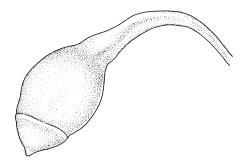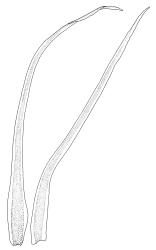- ≡ Webera pyriformis Hedw., Sp. Musc. Frond. 169 (1801)
Plants bright green, forming turves. Stems green when young, nearly black in older parts, to c. 20(–30) mm in sterile plants, mostly <10(–15) mm in fertile plants, unbranched (or rarely with subperichaetial innovations), beset at extreme base with finely papillose, red-brown rhizoids, in cross-section with a well-defined central strand and a single layer of firm-walled and elongate cortical cells. Leaves larger and crowded in an apical coma, those on lower stem wide-spreading, linear-lanceolate and c. 2 mm, those of coma abruptly tapered from an erect and oblong base to a setaceous and tubulose subula, acute, mostly 3.5–5.0 mm, bluntly denticulate near apex, strongly flexuose when dry; laminal cells of subula multistratose, linear, mostly c. 100 × 8–10 μm, thin-walled, smooth, not differentiated at margins; basal laminal cells unistratose, otherwise as those of subula. Costa filling c. ½ of base and nearly all of subula, percurrent, in cross-section (at mid subula) with large median guide cells and abaxial and adaxial substereid bands. Rhizoidal tubers present (sometimes in axils of lower leaves), ellipsoid or ± globose, brown or red-brown, 180–200 × c. 135 μm, mostly 2 cells wide, with individual cells to c. 100 μm across. Axillary hairs conspicuous under stereoscope, usually persistent on stem when leaves are removed, the lower cells quadrate and bright red-brown, the terminal cell elongate and hyaline.
Synoicous in N.Z. material. Perichaetia terminal, enclosing both red-brown axillary hairs and hyaline filiform paraphyses. Setae 18–50 mm, red-brown throughout, erect; capsules horizontal, inclined, or ± pendulous, narrowly pyriform, 2.0–2.5 mm, brown or straw-coloured, lustrous, with a well-defined and narrow neck c. 2 times the urn length; mouth narrowed and transverse; stomata numerous, restricted to neck; annulus revoluble; operculum bluntly conic. Exostome teeth well-developed, lanceolate, pale, densely papillose, trabeculate; endostome from a high basal membrane, with well-developed perforate segments ± the height of the teeth, and with 3(–4) appendiculate cilia. Calyptra cucullate and smooth. Spores 10–13 µm, spherical, nearly smooth.
Crum & Anderson 1981, fig. 247; Eddy 1996, fig. 442; Smith 2004, fig. 171, 13–17; Ochyra et al. 2008, fig. 188.
The pale, strongly lustrous, and narrowly pyriform capsules with elongate necks, together with the leaf form of this species, are highly distinctive. Despite their being placed in the same family, Leptobryum and Meesia seem unlikely to be confused. Given its well-developed bryoid peristome, L. pyriforme is more likely to be confused with members of the Bryaceae (where it was traditionally placed). However, no N.Z. representatives of the Bryaceae have linear-lanceolate and setaceous leaves. When sterile, L. pyriforme could be confused with Ditrichum spp., but its characteristic nearly black stems and the conspicuous red-brown axillary hairs distinguish it. When fruiting (as it commonly is), the capsules of L. pyriforme are completely unlike any Ditrichum. Sterile material of L. pyriforme could also be confused with Orthodontium lineare. The poorly defined and generally bistratose lamina of the upper subula, its axillary hairs, and its coarsely papillose rhizoids will distinguish L. pyriforme from O. lineare. The two species favour different habitats and both commonly fruit, reducing the probability of confusion.
NI: N Auckland (Cape Maria van Diemen, Kaitāia, Tī Point, Epsom), S Auckland, Hawke's Bay (Ōpoutama, Nūhaka), Wellington (Ohakune, north-west Ruahine Range, Hōkio Beach); SI: Nelson (no locality), Canterbury, Westland (Kellys Creek), Otago, Southland (Awarua); Ch. Also occurring throughout as an abundant glasshouse weed.
Nearly cosmopolitan and possibly adventive. Widespread in temperate and colder regions of both northern and southern hemispheres; also recorded from scattered tropical localities (Crum & Anderson 1981).
On damp soil or humus, often in swamps, marshes, or damp, disturbed habitats such as drainage ditches, roadside banks. Occasionally on pockets of soil over rock (especially limestone). From sea level to at least 700 m elevation. Also occurring abundantly on potting-mix in glasshouses and in similar artificial situations.








